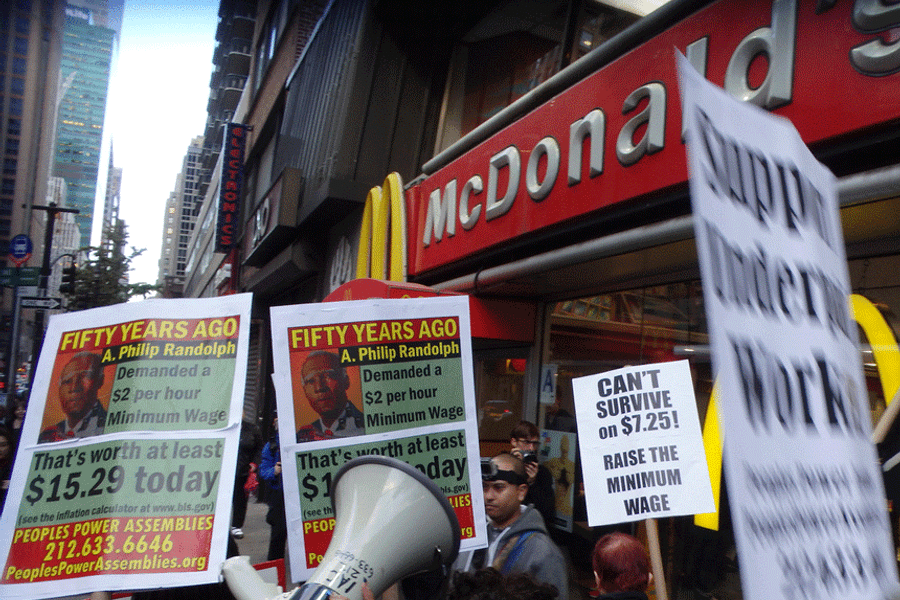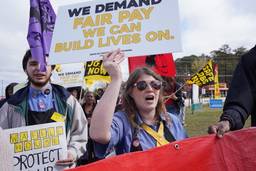
The sylvan silence of McDonald’s suburban Chicago corporate headquarters provides executives of the world’s largest fast-food corporation a retreat far from its 860,000 U.S. workers — who face a schedule of days defined by sizzling grease, fast-paced work and low wages.
But on the eve of the company’s May 22 annual meeting in Oak Brook, Illinois, well over 1,500 chanting, singing and sign-waving McDonald’s employees and their supporters brought the reality of fast food work to the front steps of the wooded corporate retreat. The marchers, reflecting an amalgam of labor and civil rights cultures, chanted that they were “the mighty, mighty union,” and sang “We Shall Overcome.” North Carolina NAACP president Rev. Dr. William Barber, whose “Moral Mondays” demonstrations have strengthened that state’s labor-civil rights alliance, joined the march, symbolizing the recent growth of local low-wage, fast food worker movements in the South.
The marchers wanted to deliver the message that working at fast-food restaurants cripples the dreams of millions of Americans who find it hard to support themselves and their families on a McDonald’s paycheck. For the past year and a half, the “Fight for 15” movement has confronted many major fast food companies with two demands: a minimum wage of $15 an hour and the right to form a union without managerial interference. To be sure the message was received, protesters greeted shareholders on Thursday morning as they arrived at the company headquarters.
On Wednesday, Chicago high school senior Kimberly Edwards, 17, marched alongside her single mother — who has worked at McDonald’s while raising her three children — because she wanted her mom to have a union and higher pay. That way, Kimberly says, she would be able to better support her family and make it possible for Kimberly to go to college. “I know the story of being a low-paid worker,” she said. “They break their backs and don’t get what they deserve. It’s difficult for us. We need the money.”
Police in riot gear halted the peaceful march as it moved down Kroc Drive on the headquarter’s campus. After the protesters sat down and blocked the road, named after McDonald’s Corporation founder Ray Kroc, 101 workers and at least 36 of their supporters were arrested on trespassing charges. Among them were many clergy and Mary Kay Henry, president of the Service Employees International Union.
Even if the marchers made only a symbolic breach onto corporate property, the word has gotten through to McDonald’s: Its financial reports cite protests over low wages and public concern with inequality as risks threatening future corporate performance.
Wednesday’s action came less than a week after a day of strikes and protests against McDonald’s in 230 cities around the world. The movement has grown quickly since fast-food workers in New York City first walked out of work in November 2012 in protest over wages, inadequate work hours, unpredictable schedules, a lack of benefits and other complaints about the industry. With funding and organizational support from SEIU, the campaign has spread to nearly 150 U.S. cities.
Growing public discontent with economic inequality has made fast food executive pay a vulnerable target and given protesting workers increased leverage with the corporation. According to a report from Demos, a New York-based think tank, the greatest disparity between CEO and worker pay exists in the accommodation and food services industry, with fast-food operations like McDonald’s acting as “a major driver of large scale pay disparity.” It calculated that since 2012, the ratio of CEO pay to worker pay has been more than 1,000 to 1, roughly double that of other industries.
Although the annual meeting ratified the board’s executive pay proposal, McDonald’s executives are not earning their pay increases from a business perspective: share prices have lagged behind the S&P 500, domestic sales dropped in the last quarter of 2013 and franchisee discontent has grown.
McDonald’s low-pay policy sets a pattern for much of corporate America, but the company’s pay strategy depresses its workers’ purchasing power, making it hard for them to buy even the products they make (in a memo on how to survive on their wages, the company advised its employees not to buy fast food).
But more than money is at stake. Many McDonald’s workers said they were protesting not only for themselves but for the sake of others, including the families they support, as well as for fellow workers who are not yet ready to assert their rights. Tiara Jackson, 21, was prepared to risk arrest because she needs to earn more to support her 4-year-old daughter and younger brother. Jackson hopes the protest will make it clear to management that workers are more than a means to an end. “We are working for ourselves,” she says. “We are not working for management.” But she is also working for the common good. “My mother, she thinks I’m doing a good thing … doing this is not just for myself but for others.”
Despite the breadth of the rapidly spreading campaign, it remains relatively shallow: Most of the workers involved at this stage in the campaign represent a small minority of workers in individual fast food outlets, as well as within the industry as a whole. Jackson, for example, says she is the only open supporter at her restaurant. She says that many co-workers are sympathetic to the movement’s demands though remain cautious about speaking up. But typically, early grass-roots leaders — such as those protesting this week in Oak Brook — are motivated not only by their hope for just pay, but also by morality, solidarity and a desire to make a difference in the world.
When these workers protest, they inspire other workers to believe in the possibility of changing their conditions of work. At that level, as well as in making the case that workers have been underpaid and mistreated, the “Fight for 15” has reached both the vast fast food workforce and the general public. Their fight also has given additional urgency to federal, state and local plans to raise the minimum wage.
SEIU President Henry says that she is pleased to see the mutual reinforcement of the “Fight for 15” and the minimum wage battles, but they are different. Even though the $15 goal is likely to be implemented in steps, she says, the workers still need to be involved in a process of negotiation with employers. But unlike traditional organizing, which leads — if organizers are lucky — to union recognition and a contract, this campaign has defined its goal for now as a right to unionize without interference, as well as higher pay. Henry says that SEIU is already working on how to select worker representatives for preliminary discussions with employers, which could include agreements on codes of conduct for managers and organizers during union organizing, as well as on a schedule of pay increases.
The direct actions — from the six strikes in growing numbers of cities over the past year and one-half to the protests of the past two weeks — seem to be creating an interest and sense of hope among an emerging group of fast food workers who could be leaders in organizing a union. And they have built public support that workers will almost certainly need to pressure McDonald’s and other fast-food giants to raise wages or agree to refrain from interfering with their employees’ decisions regarding unionization.
The current process differs from a traditional unionization drive, just as the OUR Walmart organizing is different from “Fight for 15.” Rather than focusing almost entirely on building majority worker support in individual workplaces, the fast food “Fight for 15” campaign focuses on an industry, recruits broadly and relies heavily on organizational allies and public sympathy.
Henry acknowledges that difference happily, saying that organizing will need to move in the direction represented by the fast food campaign. But much as tactics and strategies may change, a union of any real consequence is not likely to emerge without vigorous, widespread activity by workers themselves, starting with the process of organizing. And while community support becomes especially important in these tough, post-recession times, workers themselves will necessarily play the central role. If the “Fight for 15” can succeed, especially for fast food workers at the bottom of our increasingly inequitable economy, a victory for them could be truly a victory for all.
David Moberg, a former senior editor of In These Times, was on staff with the magazine from when it began publishing in 1976 until his passing in July 2022. Before joining In These Times, he completed his work for a Ph.D. in anthropology at the University of Chicago and worked for Newsweek. He received fellowships from the John D. and Catherine T. MacArthur Foundation and the Nation Institute for research on the new global economy.







